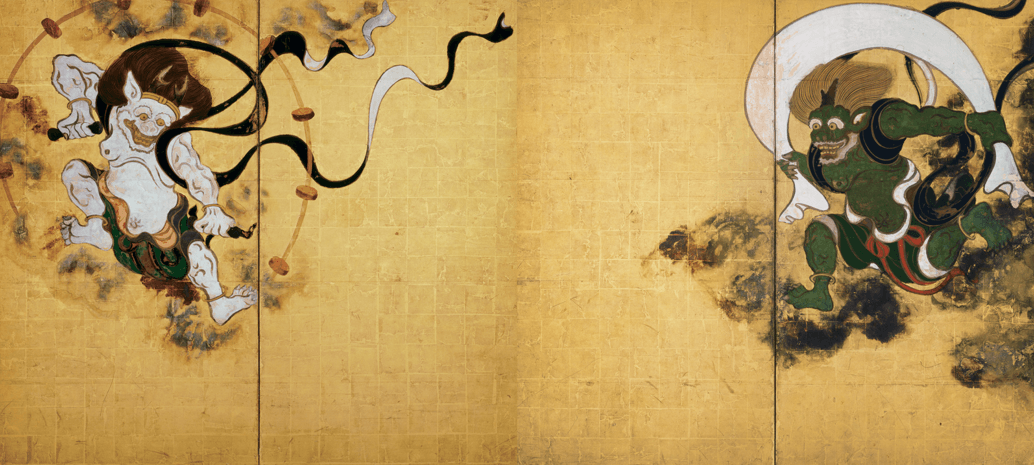Tawaraya Sōtatsu facts for kids
Quick facts for kids
Tawaraya Sōtatsu
|
|
|---|---|
| 俵屋 宗達 | |
| Born | c. 1570 |
| Died | c. 1640 |
| Nationality | Japanese |
| Known for | Painting |
|
Notable work
|
|
| Movement | Rinpa school |
Tawaraya Sōtatsu (俵屋 宗達, c. 1570 – c. 1640) was a very important Japanese painter and designer. He lived a long time ago, from about 1570 to 1640. He helped start a special art style called the Rinpa school.
Sōtatsu is famous for decorating beautiful writings by his friend Hon'ami Kōetsu. He also made amazing folding screens called byōbu. Two of his most famous screens are Wind God and Thunder God and his paintings from The Tale of Genji. These are considered National Treasures in Japan.
He also made a painting trick popular called tarashikomi. This is when you put a second layer of paint on before the first layer is completely dry. This creates cool effects!
Sōtatsu and Kōetsu are known as the founders of the Rinpa school of Japanese painting. Rinpa wasn't a strict school, but a group of artists who were inspired by Sōtatsu and Kōetsu. Some other famous Rinpa artists include Ogata Kōrin and Sakai Hōitsu.
| Top - 0-9 A B C D E F G H I J K L M N O P Q R S T U V W X Y Z |
About Sōtatsu's Life
The exact year Sōtatsu was born is not known, but it was probably around 1570. We also don't know exactly where he was born. Some people think his family name was Nonomura.
In 1602, Sōtatsu was hired for an important job. He helped fix some very old scrolls from the 12th century at the Itsukushima Shrine. These scrolls are called Heike nōkyō. Even in this early work, you can see the special style he would use later. His friend Kōetsu might have helped with this repair too.
Working with Hon'ami Kōetsu
Sōtatsu's first confirmed work with Hon'ami Kōetsu was on a big project called the Sagabon (Saga Books). This started around 1606. The goal was to publish fancy versions of old Japanese books and plays. Sōtatsu designed the covers and paper for many books. Kōetsu wrote the beautiful words inside. These books were made in a part of Kyoto called Saga.
Sōtatsu even married one of Kōetsu's cousins! He also opened his own shop in Kyoto called Tawaraya. In his shop, he sold many decorated items. These included fans, paper for lanterns, screens, dolls, and patterns for kimonos. He also took orders to decorate people's homes. His shop quickly became famous for its amazing art.
Around 1620, Sōtatsu and Kōetsu stopped working together. This might be because Sōtatsu wanted to focus more on being a painter, rather than just a decorator.
In 1621, he decorated doors and screens for the Yōgen-in temple. This temple was being rebuilt by the wife of a powerful leader, Tokugawa Hidetada. In 1630, Sōtatsu received a special title called hokkyō. This was a high honor given to Buddhist artists.
We don't know how Sōtatsu died, but it was probably around 1640. His most successful students were Tawaraya Sōsetsu and Kitawaga Sōsetsu.
Famous Artworks
Anthology with Cranes
The Anthology with Cranes is a long scroll. Sōtatsu decorated it with silver and gold paint. Hon'ami Kōetsu added beautiful writing to it. This scroll shows some of Kōetsu's best writing and Sōtatsu's amazing decorating skills. They probably made it between 1602 and 1620, when they worked together a lot.
The scroll contains poems called waka. These poems were written by famous poets known as the Thirty-Six Immortals of Poetry. Sōtatsu's design shows cranes flying or standing all along the scroll. People praise his design for being very clever and original.
- ''Anthology with Cranes'' (details)
This scroll is about 34 cm tall and 13.5 meters long! It is kept at the Kyoto National Museum. It is considered an Important Cultural Property.
Wind God and Thunder God
Wind God and Thunder God is a pair of two-part folding screens. Sōtatsu painted them using ink and colors on gold paper. The screens show Raijin, the god of lightning and storms, and Fūjin, the god of wind. Even though there's no signature, everyone agrees Sōtatsu painted them.
This artwork is very important in the Rinpa school. Two other famous Rinpa artists, Ogata Kōrin and Sakai Hōitsu, later painted their own versions to honor Sōtatsu. In 2015, all three versions were shown together for the first time in 75 years! This happened at an exhibition in the Kyoto National Museum.
- ''Wind God and Thunder God''
Each screen is about 170 cm tall and 154 cm wide. They belong to the Zen Buddhist temple Kennin-ji in Kyoto. Sometimes, they are shown at the Kyoto National Museum. They are a National Treasure of Japan.
Exhibitions
The Freer Gallery of Art in the United States held the first big show of Sōtatsu's art outside Japan. It was from October 2015 to January 2016.
See also
 In Spanish: Tawaraya Sōtatsu para niños
In Spanish: Tawaraya Sōtatsu para niños




